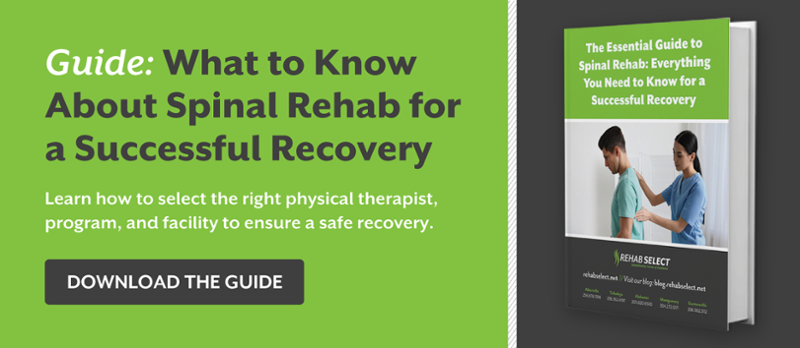
Your back surgery recovery depends on many things, from your overall health to the degree of symptoms you had before surgery to the type of procedure you had done.
While you may have activity restrictions in the timeframe immediately following surgery, eventually your physician will want to get you moving again. In many cases, your surgeon may refer you to an inpatient rehab program after your surgery so that your activity can be supervised and safely guided by professional therapists.
Here, we’ll examine the recovery stages for some common spinal surgery procedures and provide tips for getting the most out of your recovery.
Recovery from back surgery is a balancing act
Whatever back surgery you have, your recovery will take place in gradual stages. It’s a balancing act between not going too fast and injuring yourself again, while carefully retraining your body to work properly.
The time for recovery from back surgery and levels of pain experienced will be different for everyone, depending on factors like:
- Age
- Weight
- Overall health and fitness
- How serious your condition is
- What kind of operation you've had
Recovery from back surgery can range from a few weeks to a year.
Recovery from laminectomy and foraminotomy surgeries for spinal stenosis
If you’ve had a laminectomy or foraminotomy, your body may need between three months and a year to recuperate.
You can expect to be discharged from the hospital within a few days of surgery. You’ll be sent home with a prescription for strong painkillers and perhaps some medication to make going to the bathroom easier.
For the first four weeks, reduce or avoid strenuous activities to protect your spine from damage. However, some activity is necessary to help you during your recovery time for back surgery. A physical therapist at an inpatient rehab facility can help you strike the right balance.
You should be given the all-clear to drive again within eight weeks, as long as you’re not taking strong opioid-based painkillers.
The normal recovery time for back surgery after a laminectomy or foraminotomy is between two and six months. However, you may find the area that was operated on will never be as flexible as it once was.
Newer alternatives to these traditional surgeries for spinal stenosis may be a better option. Modern, minimally invasive techniques are less painful, require less time in the hospital, and allow you to recover faster.
Recovery from spinal fusion surgery
Back fusion surgery recovery can be a long road. Your vertebral segments will begin fusing during the first few months, but this process can last up to a year. Physical therapy may be advised to make sure you’re on the right track.
Young and fit spinal fusion patients can probably drive again after a month, get back to an office-type job within a month and a half, and return to a normal life, more or less, within six months. If you’re older or need more complicated surgery, back fusion surgery recovery is slower. If you have a manual job, it can take up to half a year to return to work.
Because recovery is more complicated, your surgeon may refer you to an inpatient rehab facility that offers post-surgical therapy programs. In this environment, you’ll be supervised around the clock with access to a multidimensional therapy team to guide your recovery.
However, spinal fusion is quite an old technique and patients risk a range of complications. It’s now being superseded by total disc replacement.
Recovery from artificial disc replacement surgery
In artificial disc replacement surgery, your failing disc is removed and the surgeon inserts an artificial one made from material that works almost as well as the real thing. Not only does this leave you with a much more flexible and natural-feeling spine, but the new technique is less painful. It also has fewer complications and allows you to get up and around within a day, get back to your job within six weeks and recover almost completely in three to twelve weeks–depending on your health, age, and fitness level. Your surgeon will probably recommend physical therapy and explain some movements that you should avoid.
8 tips for helping to improve recovery from back surgery.
Your recovery from back surgery may involve an orthopedic rehab team, and you can play a big part in a successful recovery:
-
Pay attention to your doctor’s advice.
Sometimes people think they’re tough and push themselves too hard, which can cause complications and undo all the surgeon’s hard work. Remember, your doctor has seen your spine from the inside, they know what’s really going on in there!
-
Get better before surgery.
If you haven’t had surgery yet, you should concentrate on getting fitter and healthier right now. The better condition you’re in when you have surgery, the easier and quicker your recovery will be. Talk to a physical therapist who will be able to explain the best ways you can exercise despite your pain.
-
Find out if inpatient therapy is recommended.
Be sure to ask your surgeon if post-operative inpatient therapy can help you. You’ll need to be referred for this kind of therapy, which combines multiple approaches like physical and occupational therapy into a highly personalized treatment program. Twenty-four-hour care from a multidisciplinary team of surgical rehab therapists and support specialists can safely accelerate your progress toward recovery.
-
Show up.
Your doctor needs to monitor your progress to make sure everything is going according to plan or if something needs to be dealt with. Make sure you attend your check-in appointments and don’t be afraid to get in touch if you experience a relapse or you notice something wrong.
-
Think before you move.
In your condition, your spine won’t respond well to movements like bending over, lifting anything heavier than a bag of potatoes, lifting over your head, or twisting at the waist. A physiotherapist can help you learn to use alternative movements during your recovery period. For example, instead of twisting around at the waist, you should use your feet to shift your position and avoid straining your spine. Your physiotherapist can also advise on the safest ways to do everyday things like getting into a car or getting out of bed.
-
But don’t stop moving.
Because some movements are out of bounds, it might seem logical that moving as little as possible is your best option. However, your recovery requires movement to progress. Spending too long in bed or on the couch means your muscles won’t get the exercise they need to get better. Plus, moving around will help you feel better physically and mentally.
-
Reach for a helping claw.
This gadget (a pair of pincers on the end of a long handle) is very helpful for picking up and grabbing things while you’re unable to make the movements mentioned above.
-
Break out the slip-ons.
Slip-on-shoes or slippers mean you don’t have to worry about how you’re going to tie your laces.
Recovery from back surgery in Alabama
While safe recovery from back surgery can’t be rushed, there is a right and a wrong way to do it. Rehab Select’s post-surgical inpatient rehab is provided by a team of highly skilled professionals who will tailor a recovery plan to meet your specific needs. Choose from one of the five Alabama locations of Rehab Select as the place to ensure a safe and successful return to your workplace, family, and social life. Click here to schedule a meeting or tour today to see how we can help you on your journey of recovery.





